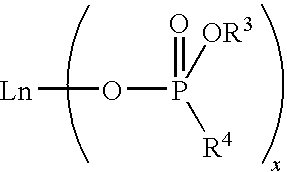Bulk polymerization process for producing polydienes
a polydiene and polymerization process technology, applied in physical/chemical process catalysts, organic compounds/hydrides/coordination complex catalysts, physical/chemical process catalysts, etc., can solve the problems of reducing the cost of polymer production, and affecting the quality of polydien
- Summary
- Abstract
- Description
- Claims
- Application Information
AI Technical Summary
Benefits of technology
Problems solved by technology
Method used
Image
Examples
example 1
[0099]In this experiment, cis-1,4-polybutadiene was prepared by polymerizing 1,3-butadiene monomer in bulk with a catalyst system comprising neodymium bis(2-ethylhexyl)phosphate (abbreviated as NdP hereinafter), triisobutylaluminum (TIBA), and ethylaluminum dichloride (EADC). A commercially available 0.126 M NdP solution in methylcyclohexane was used as the NdP source. This solution was found to be highly viscous and difficult to transfer.
[0100]The polymerization reactor consisted of a one-gallon stainless-steel reactor equipped with a mechanical agitator (shaft and blades) capable of mixing high viscosity polymer cement. The top of the reactor was connected to a reflux condenser system for conveying, condensing, and recycling the 1,3-butadiene vapor developed inside the reactor throughout the duration of the polymerization. The reactor was also equipped with a cooling jacket containing cold water. The heat of polymerization was dissipated partly by internal cooling through the use ...
example 2
[0103]In this experiment, cis-1,4-polybutadiene was prepared by polymerizing 1,3-butadiene monomer in bulk with the same catalyst system as used in Example 1, except that the highly viscous NdP solution was first thoroughly pre-mixed with the monomer prior to adding other catalyst components.
[0104]The same reactor preparation procedure as used in Example 1 was used. About 651 g of 1,3-butadiene monomer was charged into the reactor. After the monomer was thermostated at 32° C., 0.98 mL of 0.126 M NdP in methylcyclohexane was charged into the reactor. After the resulting mixture was stirred for 1.5 hours to ensure the complete dissolution of the viscous NdP solution into the monomer, 7.40 mL of 1.0 M TIBA in hexane was charged into the reactor. The polymerization was then initiated by charging 2.90 mL of 0.074 M EADC in hexane into the reactor. After 11.7 minutes from its commencement, the polymerization was terminated by the addition of 4.56 mL of isopropanol in 1360 g of hexane. The...
examples 3
[0107]In this experiment, a low-viscosity NdP solution was prepared by treating a commercially available, high-viscosity NdP solution with a small amount of a Lewis acid.
[0108]About 0.18 mL of 1.0 M tin tetrachloride (TTC) in hexane was added to 38.1 mL of the commercially available 0.126 M NdP solution in methylcyclohexane. Upon mixing, the viscosity of the NdP solution decreased significantly, yielding a much less viscous solution. The resulting NdP solution (referred to as TTC-modified NdP solution hereinafter) had a concentration of 0.125 M. It was found that the TTC-modified NdP solution was easy to transfer and easy to mix with other catalyst components or the monomer without the need to employ a long mixing time. Therefore, the TTC-modified NdP solution was employed in subsequent polymerization experiments.
PUM
| Property | Measurement | Unit |
|---|---|---|
| molar ratio | aaaaa | aaaaa |
| molecular weight distribution | aaaaa | aaaaa |
| Brookfield viscosity | aaaaa | aaaaa |
Abstract
Description
Claims
Application Information
 Login to View More
Login to View More - R&D
- Intellectual Property
- Life Sciences
- Materials
- Tech Scout
- Unparalleled Data Quality
- Higher Quality Content
- 60% Fewer Hallucinations
Browse by: Latest US Patents, China's latest patents, Technical Efficacy Thesaurus, Application Domain, Technology Topic, Popular Technical Reports.
© 2025 PatSnap. All rights reserved.Legal|Privacy policy|Modern Slavery Act Transparency Statement|Sitemap|About US| Contact US: help@patsnap.com



